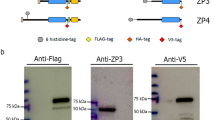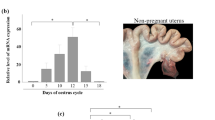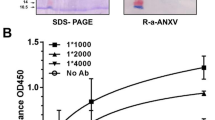Abstract
THE availability of a species-specific antibody against mouse eggs which did not react with mouse somatic cells1,2 has made it possible to determine the presence of the “egg antigen” in both oocytes and developing embryos. Oocytes were obtained from Swiss albino 1CR mice either by disruption of intact ovaries with thin needles (4 to 6-day-old mice) or by disruption of follicles (older mice). Unfertilized eggs were obtained from superovulated Swiss mice as before3. Embryos at different stages of development were flushed from oviducts and uteri of untreated Swiss mice at various times after mating. The day on which the vaginal plug became visible was counted as the first day of pregnancy. Postimplantation embryos were dissected by Kirby's4 technique and cumuli oophori and zonae pellucidae were removed by the standard procedure3. Trophoblast cultures were established from late blastocysts maintained in the wells of microtest tissue culture plates for 48 h in Eagle's minimum essential medium supplemented with 10% foetal bovine serum. Trophoblast giant cells were obtained from ectoplacental cones of 7.5-day-old embryos which had been treated for 15 min with a 0.25% trypsin solution, containing 200 µg of DNAase/ml. to remove adhering fibrinoid deposits5.
This is a preview of subscription content, access via your institution
Access options
Subscribe to this journal
Receive 51 print issues and online access
$199.00 per year
only $3.90 per issue
Buy this article
- Purchase on Springer Link
- Instant access to full article PDF
Prices may be subject to local taxes which are calculated during checkout
Similar content being viewed by others
References
Baranska, W., Koldovsky, P., and Koprowski, H., Proc. US Nat. Acad. Sci., 67, 193 (1970).
Koprowski, H., Sawicki, W., and Koldovsky, P., J. Nat. Cancer Inst., 46, 1317 (1971).
Moskalewski, S., Sawicki, W., Gabara, B., and Koprowski, H., J. Exp. Zool. (in the press).
Kirby, D. R. S., in Methods in Mammalian Embryology (edit. by Daniel, jun., J. C.), 146 (Freeman, San Francisco, 1971).
Kirby, D. R. S., Billington, W. D., Bradbury, S., and Goldstein, D. J., Nature, 204, 548 (1964).
Bodmer, W., Tripp, M., and Bodmer, J., in Histocompatibility Testing (edit. by Curtoni, E. S., Mattiuz, P. L., and Tosi, R. M.), 341 (Williams and Wilkins, Baltimore, 1967).
Rotman, B., and Papermaster, B. W., Proc. US Nat. Acad. Sci., 55, 134 (1966).
Mintz, B., J. Exp. Zool., 157, 85 (1964).
Monesi, V., and Salfi, V., Exp. Cell Res., 46, 632 (1967).
Heyner, S., Brinster, R. L., and Palm, J., Nature, 222, 783 (1969).
Palm, J., Heyner, S., and Brinster, R. L., J. Exp. Med., 133, 1282 (1971).
Author information
Authors and Affiliations
Rights and permissions
About this article
Cite this article
MOSKALEWSKI, S., KOPROWSKI, H. Presence of Egg Antigen in Immature Oocytes and Preimplantation Embryos. Nature 237, 167–168 (1972). https://doi.org/10.1038/237167a0
Received:
Issue Date:
DOI: https://doi.org/10.1038/237167a0
Comments
By submitting a comment you agree to abide by our Terms and Community Guidelines. If you find something abusive or that does not comply with our terms or guidelines please flag it as inappropriate.



